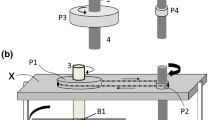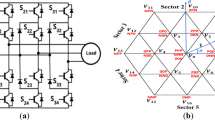Abstract
This paper presents an improved magnetic equivalent circuit (MEC) method for modeling linear permanent-magnet synchronous motors (LPMSMs) with adjustable accuracy. The performance of machine with different dimensions, poles and slot numbers can be studied by the proposed flexible MEC, where the core nonlinearity is fitted on the material B–H curve. End effect is modeled by considering two virtual zones with desired accuracy at both entrance and exit ends of the primary. A new structure based on magnets segmentation is also proposed to investigate its effect on the motor performance. Finally, the results of the proposed method are compared with 3D-FEM to show the effectiveness of the presented model. The results show improvement in processing time with good accuracy compared to previous classic methods. In general, introducing a new model based on an improved MEC approach for modeling LPMSMs considering slot effect, iron core saturation and segmented PMs with flexible accuracy by adjusting the number of flux tubes is the paper novelty which is studied in this work.









Similar content being viewed by others
References
Gieras JF, Piech ZJ, Tomczuk B (2018) Linear synchronous motors: transportation and automation systems. CRC Press, Boca Raton
Yamazaki K, Fukushima Y, Sato M (2008) Loss analysis of permanent magnet motors with concentrated windings-variation of magnet eddy current loss due to stator and rotor shapes. In: 2008 IEEE industry applications society annual meeting. IEEE, pp 1–8
Pfister P-D, Perriard Y (2009) Very-high-speed slotless permanent-magnet motors: analytical modeling, optimization, design, and torque measurement methods. IEEE Trans Ind Electron 57(1):296–303
Vaez-Zadeh S, Isfahani AH (2006) Enhanced modeling of linear permanent-magnet synchronous motors. IEEE Trans Magn 43(1):33–39
Kang Gyu-Hong, Hong Jung-Pyo, Kim Gyu-Tak (2001) A novel design of an air-core type permanent magnet linear brushless motor by space harmonics field analysis. IEEE Trans Magn 37:3732–3736
Chung M-J, Gweon D-G (2002) Modeling of the armature slotting effect in the magnetic field distribution of a linear permanent magnet motor. Electr Eng 84:101–108
Zarko D, Ban D, Lipo TA (2006) Analytical calculation of magnetic field distribution in the slotted air gap of a surface permanent-magnet motor using complex relative air-gap permeance. IEEE Trans Magn 42:1828–1837
Boldea I, Babescu M (1978) Multilayer approach to the analysis of single-sided linear induction motors. Proc Inst Electr Eng 125:01
Azzouzi J, Barakat G, Dakyo B (2005) Analytical modeling of an axial flux permanent magnet synchronous generator for wind energy application. IEEE Int Conf Electric Mach Drives 2005:1255–1260
Hosseini MS, Vaez-Zadeh S (2010) Modeling and analysis of linear synchronous motors in high-speed maglev vehicles. IEEE Trans Magn 46:2656–2664
Min SG, Sarlioglu B (2017) 3-d performance analysis and multiobjective optimization of coreless-type pm linear synchronous motors. IEEE Trans Industr Electron 65(2):1855–1864
Chi S, Yan J, Shan L, Wang P (2019) Detent force minimizing for moving-magnet-type linear synchronous motor. IEEE Trans Magn 55(6):1–5
Kumar RS, Umadevi K, Anup C (2016) Performance analysis of permanent magnet linear synchronous motors using finite element method. In: 2016 international conference on electrical, electronics, and optimization techniques (ICEEOT). IEEE, pp 1–7
Song J, Lee JH, Kim D, Kim Y, Jung S (2017) Analysis and modeling of concentrated winding variable flux memory motor using magnetic equivalent circuit method. IEEE Trans Magn 53:1–4
Ren Z, Fang X, Wang S, Qiu J, Zhu JG, Guo Y, Yang X, Ha J, Wang Z, Sun Y et al (2007) Design optimization of an interior-type permanent magnet BLDC motor using PSO and improved MEC. In: 2007 international conference on electrical machines and systems (ICEMS). IEEE, pp 1350–1353
Sheikh-Ghalavand B, Vaez-Zadeh S, Isfahani AH (2009) An improved magnetic equivalent circuit model for iron-core linear permanent-magnet synchronous motors. IEEE Trans Magn 46(1):112–120
Naderi P, Rostami M, Ramezannezhad A (2019) Phase-to-phase fault detection method for synchronous reluctance machine using MEC method. Electr Eng 101(2):575–586
Dziechciarz A, Martis C (2017) Simplified model of synchronous reluctance machine with optimized flux barriers. Electr Eng 99(4):1207–1216
Ghandehari R, Naderi P, Vandevelde L (2021) Performance analysis of a new type pm-resolver in healthy and eccentric cases by an improved parametric MEC method. IEEE Trans Instrum Meas 70:1–10
Naderi P, Ghandehari R, Heidary M (2021) A comprehensive analysis on the healthy and faulty two types vr-resolvers with eccentricity and inter-turn faults. IEEE Trans Energy Convers 1–1
Hendershot JR, Miller TJE (2010) Design of brushless permanent-magnet machines. Motor Design Books Venice, Florida
Chen Y-M, Fan S-Y, Lu W-S (2004) Performance analysis of linear permanent magnet motors for optimal design considerations, In: Nineteenth annual IEEE applied power electronics conference and exposition, 2004. APEC’04, vol 3. IEEE, pp 1584–1589
Kano Y, Kosaka T, Matsui N (2005) Simple nonlinear magnetic analysis for permanent-magnet motors. IEEE Trans Ind Appl 41(5):1205–1214
Hwang C-C, Cho Y (2001) Effects of leakage flux on magnetic fields of interior permanent magnet synchronous motors. IEEE Trans Magn 37(4):3021–3024
Qu R, Lipo TA (2004) Analysis and modeling of air-gap and zigzag leakage fluxes in a surface-mounted permanent-magnet machine. IEEE Trans Ind Appl 40(1):121–127
Chen X, Zhu Z-Q, Howe D (2009) Modeling and analysis of a tubular oscillating permanent-magnet actuator. IEEE Trans Ind Appl 45(6):1961–1970
Wakiwaka H (2019) Magnetic application in linear motor. In: Magnetic material for motor drive systems. Springer, pp 423–437
Naderi P, Shiri A (2018) Modeling of ladder-secondary-linear induction machine using magnetic equivalent circuit. IEEE Trans Veh Technol 67(12):11411–11419
Naderi P, Heydari M, Vahedi M (2020) Performance analysis of ladder secondary linear induction motor with two different secondary types using magnetic equivalent circuit. ISA Trans 103:355–365
Wang Y, Ma J, Liu C, Lei G, Guo Y, Zhu J (2019) Reduction of magnet eddy current loss in PMSM by using partial magnet segment method. IEEE Trans Magn 55(7):1–5
Lu Q, Wu B, Yao Y, Shen Y, Jiang Q (2019) Analytical model of permanent magnet linear synchronous machines considering end effect and slotting effect. IEEE Trans Energy Convers 35(1):139–148
Acknowledgements
This work was supported by Shahid Rajaee Teacher Training University under contract number 6189.
Author information
Authors and Affiliations
Corresponding author
Additional information
Publisher's Note
Springer Nature remains neutral with regard to jurisdictional claims in published maps and institutional affiliations.
Rights and permissions
About this article
Cite this article
Heidary, M., Naderi, P. & Shiri, A. Modeling and analysis of a multi-segmented linear permanent-magnet synchronous machine using a parametric magnetic equivalent circuit. Electr Eng 104, 705–715 (2022). https://doi.org/10.1007/s00202-021-01334-1
Received:
Accepted:
Published:
Issue Date:
DOI: https://doi.org/10.1007/s00202-021-01334-1




